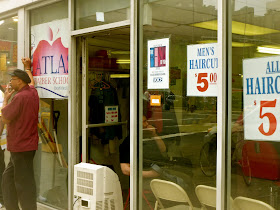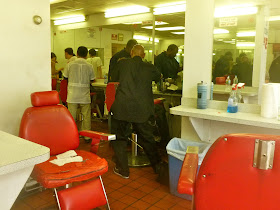The Chelsea Gallery Diner has closed after 30 years in business on 7th Avenue near 14th Street.

photo: Visual Raconteur's flickr
Scott Stiffler has a eulogy for the place in Chelsea Now, and JVNY reader Tim Kirk sent in the sad news with a quick video he took of the shutter signage.
Quite pointedly, the sign reads: "Due to our Madison Ave. lease and a dying customer base we have been forced to close our doors after 30 yrs at this location. We have watched our quaint neighborhood turn into the very ‘upscale Chelsea’ of today’s Manhattan. So let us remember a time when this diner was a meeting place for so many strange, unusual & different people to say the least. All were welcomed at a time when St. Vincent’s stood tall, the Halloween Parade was small and our diner at any given time could turn into a fun free for all."

Writes Tim, "This was the kind of place where the management would feed locally known homeless people fresh food right outside the door. Can you imagine ANY joint in Chelsea being that compassionate to those less fortunate these days?"
Always accommodating to large groups, the compassionate Chelsea Gallery was also a safe haven for, as the sign says, the "unusual" people. On any given night, you might walk in to find the back tables full of trekkers from the New York City Star Trek meet-up, gay bears and their admirers getting together, transgender folks mixing and mingling after a support group, or sober gays and lesbians coming in for fellowship after their 12-step meetings. Many crowds came from the nearby LGBT Center--the Chelsea Gallery was a regular after-meeting haunt.

Adam Kuban's flickr
It was also not a place for the hyper-young and hip. Chelsea Gallery was the diner of choice for the NYC Individualists' Single 40 Plus social club (for the "not societally gorgeous, not religious, not slim, you're into politics, psychology, not perfect, too intellectual, left wing, chicken wing!!not a swinging single, not a drinker, not a smoker, not rich, not a Wall St. or Madison Ave. groupie, not a Happy Hour junkie, don't wear make up, or high heels, or ties, maybe you have beards, tatoos, long hair, maybe you are YOU!!").
These motley crowds could be off-putting to some newcomers to the city.
Noted one blogger who tried the Chelsea Gallery: "maybe there’s some kind of early bird special because all the old people in nyc are sitting right in my face. There are a sprinkle of young, my age, gay and lesbian couples here and there, but majority of them are old. They’re eating [alone], or they came with their girlfriends and families to chat. Not that I have a problem with that, it’s just a new experience that’s all. I thought I was at the old folk’s home or something. Let me tell you, this is certainly not a trendy place." [emphases mine]

Adam Kuban's flickr
Of course, if it's not a trendy place, it's not allowed to exist in the new New York. And I keep wondering: Where are all those people going to go now? All the trekkers, gay bears, and transsexuals, the sober queers and the over-40 individualists, not to mention "all the old people in nyc"--where will they go?
Where will any of us go when every single place we feel at home is wiped from the face of the city?















































